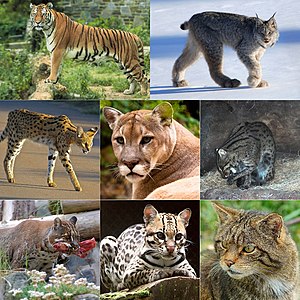Portal:Cats
The Cats PortalFelidae (/ˈfɛlɪdiː/) is the family of mammals in the order Carnivora colloquially referred to as cats. A member of this family is also called a felid (/ˈfiːlɪd/). The term "cat" refers both to felids in general and specifically to the domestic cat (Felis catus). The 41 extant Felidae species exhibit the greatest diversity in fur patterns of all terrestrial carnivores. Cats have retractile claws, slender muscular bodies and strong flexible forelimbs. Their teeth and facial muscles allow for a powerful bite. They are all obligate carnivores, and most are solitary predators ambushing or stalking their prey. Wild cats occur in Africa, Europe, Asia and the Americas. Some wild cat species are adapted to forest and savanna habitats, some to arid environments, and a few also to wetlands and mountainous terrain. Their activity patterns range from nocturnal and crepuscular to diurnal, depending on their preferred prey species. (Full article...) Selected species - The Canada lynx (Lynx canadensis) or Canadian lynx is one of the four living species in the genus Lynx. It is a medium-sized wild cat characterized by long, dense fur, triangular ears with black tufts at the tips, and broad, snowshoe-like paws. Its hindlimbs are longer than the forelimbs, so its back slopes downward to the front. The Canada lynx stands 48–56 cm (19–22 in) tall at the shoulder and weighs between 5 and 17 kg (11 and 37 lb). It is a good swimmer and an agile climber. The Canada lynx was first described by Robert Kerr in 1792. Three subspecies have been proposed, but their validity is doubted; it is mostly considered a monotypic species. It ranges across Alaska, Canada and northern areas of the contiguous United States, where it predominantly inhabits dense boreal forests. It is a specialist predator and depends heavily on the snowshoe hare (Lepus americanus) for food. This leads to a prey-predator cycle, as the Canada lynx population responds to the cyclic rises and falls in snowshoe hare populations over the years in Alaska and central Canada. The Canada lynx population increases with an increasing hare population; if the hare population decreases in a given area, it moves to areas with more hares and has fewer offspring. The Canada lynx hunts mainly around twilight, or at night, when the snowshoe hare tends to be active. The Canada lynx waits for the hare on specific trails or in "ambush beds", then pounces on it and kills it by a bite on its head, throat or the nape of its neck. Individuals, particularly of the same sex, tend to avoid each other, forming "intrasexual" territories. The mating season is roughly a month long from March to early April. After a gestation of two to three months, females give birth to a litter of one to eight kittens, which are weaned at the age of 12 weeks. (Full article...) List articles
Related portalsWikiProjectsSelected breed -The Burmese cat (Burmese: ဗမာကြောင်, Băma kyaung, Thai: ทองแดง or ศุภลักษณ์, RTGS: Thongdaeng or Supphalak, meaning copper colour) is a breed of domestic cat, originating in Burma, believed to have its roots near the Thai-Burma border and developed in the United States and Britain. Most modern Burmese are descendants of one female cat called Wong Mau, which was brought from Burma to the United States in 1930 and bred with American Siamese. From there, American and British breeders developed distinctly different Burmese breed standards, which is unusual among pedigreed domestic cats. Most modern cat registries do not formally recognise the two as separate breeds, but those that do refer to the British type as the European Burmese. (Full article...) Did you know... -
TopicsAssociated WikimediaThe following Wikimedia Foundation sister projects provide more on this subject:
Discover Wikipedia using portals |
























